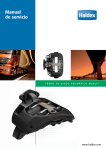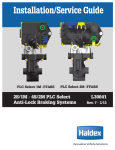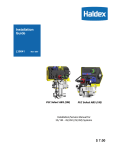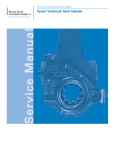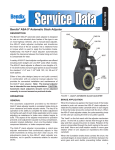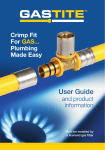Download Service Manual Truck and Trailer Applications
Transcript
Service Manual Truck and Trailer Applications L30033 8/10 Automatic Brake Adjusters Table of Contents Operation ........................................................ 1 Brake Adjuster Part Number and Build Date .............................................. 1 Steer Axle Applications .............................. 2 Drive Axle Applications .............................. 2 Trailer Axle Applications ............................ 3 Warning: Haldex strongly recommends routine visual checks be performed at EACH maintenance service interval. Foundation brake operational checks utilizing CVSA level 1 applied stroke criteria should always be utilized. Manual adjustment of automatic adjusters can disguise hidden problems within the foundation brake. Brake components such as S-cams, bushings, return springs, actuators, drums and adjuster installation MUST be within manufacturer’s specifications. Adjuster control arms, wear bushings or attaching hardware that demonstrate visual damage, or which fail the operational checks, MUST be replaced immediately. Automatic Adjusters should NEVER be operated as manual adjusters except as may be necessary to get the vehicle off the road for service. Installation Procedures . . . . . . . . . . . . . .4 Routine Visual/Operational Checks . . . .6 Service and Lubrication Intervals . . . . . .6 Foundation Brake Operational Check and Troubleshooting . . . . . . . . . .7 Brake Adjuster Checking Procedures . .9 Brake Adjuster Operational Check . . . .9 Typical Parts Identification and Location . . . . . . . . . . . . . . . . . . . . .10 Torque Specifications ..................................11 Frequently Asked Questions.....................12 Additional Parts and Service Information .....................................13 Important Notice This symbol is used throughout this manual to call attention to procedures where carelessness or failure to follow specific instructions may result in personal injury and/or component damage. The descriptions and specifications contained in this service publication are current at the time of printing. Haldex Brake Products Corp. reserves the right to discontinue or modify its models and/or procedures and to change specifications at any time without notice. Operation The Haldex automatic brake adjuster is a clearance sensing brake adjuster that maintains When the Brake Applies: Upon brake application, the brake adjuster rotates and moves the shoes into contact with the drum. The clearance notch corresponds to the normal lining-to-drum clearance. As the brake application continues, the rack moves upward and rotates the one-way clutch which slips in this direction. As the brake torque increases, the coil spring load is overcome and the wormshaft is displaced axially, releasing the cone clutch. Bushing Clutch Assembly “O”Ring Heat Treated Housing Direction of Applied Stroke Wormshaft Adjustment Hex When the Brake Releases: When the brake begins its return stroke, the coil spring load returns to normal and the cone clutch is again engaged. The rack is pulled back to its original position in the notch, and any additional travel brought about by lining wear causes the rack to turn the locked one-way clutch and rotates the wormshaft through the locked cone clutch. The wormshaft then rotates the worm wheel and camshaft, adjusting the brakes. Coil Spring Enclosed Rack “O” Ring Installation Indicator Worm Wheel Clearance Notch Control Arm Fixed Point Brake Adjuster Identification Part Number: 409 prefix = Reduced maintenance adjuster 429 prefix = No-Lube™ adjuster Serial Number: First 3 digits = Day of year built Last 2 digits = Year of build After Sept. 1989 The Part No. P/N40910224 would be our adjuster part number 409-10224. Part Number P/N40910224 Serial Number Prior to Sept. 1989 The first three numbers stamped on the cover plate is the brake adjuster part number. For example: 224 would be our adjuster part number 409-10224. S/N33489 1 Typical Applications Steer Axle Figures 1–4 show typical brackets for automatic brake adjuster applications on steer axle brake assemblies. Refer to pages 4 and 5 for detailed installation procedures. Figure 1 Steer axle with clamp bracket and flat anchor stud Approx. 1/16” Figure 3 Mack 16,000# or higher rated steer axles with spider mounted bracket Figure 2 Steer axle with clamp bracket and round anchor stud Figure 4 Steer axle with strap bracket Approx. 1/16” Drive Axle Figures 5– 8 show typical brackets for automatic brake adjuster applications on drive axle brake assemblies. Refer to pages 4 and 5 for detailed installation procedures. Figure 5 16° drive axle with strap bracket Figure 6 34° drive axle with strap bracket Figure 7 Mack drive axle with clamp bracket and flat anchor stud Figure 8 0° Kenworth drive axle with strap bracket, for 8 bag air ride 2 Note: Refer to fundamental parts identification and location on page 10. Typical Applications Trailer Axle Figures 9–12 show typical brackets for automatic brake adjuster applications on trailer axle brake assemblies. Refer to pages 4 and 5 for detailed installation procedures. Figure 9 For 16-1/2" Brake Assemblies Figure 10 For 12-1/4" Brake Assemblies Figure 11 Integral cam support anchor bracket for 12-1/4" and 16-1/2" brakes Figure 12 Bolt-on cam support anchor bracket for 12-1/4" and 16-1/2" brakes Note: Refer to fundamental parts identification and location on page 10. 3 Installation Procedures Note: Configuration of anchor bracket and brake adjuster housing may vary, depending upon axle. Refer to typical applications on Page 2 and 3. Step 1 Anchor Bracket Note: Block wheels to prevent vehicle from rolling. Ensure system tank pressure is above 100 PSI. Check that the push rod is fully retracted: apply air to release spring brake. If air is not available, spring brake must be manually caged back. Install anchor bracket loosely as illustrated ( fig. 13). Some strap brackets have two mounting holes. Proper mounting location is determined by the length of adjuster arm. 5" and 5-1/2" adjuster arm lengths utilize the shorter hole location while 6" and 6-1/2" length adjusters utilize the longer hole locations. Do not tighten anchor bracket fasteners at this time. Apply “Anti-Seize” type lubricant to camshaft splines. Figure 13 Step 2 Install the brake adjuster onto the camshaft with the ad justing hex pointing away from the brake chamber (fig. 14). Secure the brake adjuster on the camshaft. Use at least one inner washer and enough outer washers to allow no more than .060 movement of adjuster on camshaft. (Per TMC recommended practice RP609-A.) Note: Do NOT pull push rod out to meet the brake adjuster. Rotate the 7/16" adjusting hex nut CLOCKWISE until the clevis hole lines up with the brake adjuster arm hole. 4 Apply anti-seize to clevis pin, install and secure with cotter pin. Figure 14 Installation Procedures Step 3 Rotate the control arm away from the adjusting hex toward the air chamber, until it comes to a definite internal stop (fig. 15). Most adjusters will be equipped with an “Installation Indicator.” Indicator must fall within the slot for proper installation with brakes fully released (fig. 16 ). If the control arm position is wrong, tight brakes will occur (fig. 17). Tighten all anchor bracket fasteners (make sure the control arm does not move from its position while tightening fasteners). Figure 15 Step 4 The adjuster must be manually adjusted at this time. Rotate the adjusting hex clockwise until the lining lightly contacts the drum. Then back-off the adjuster by turning the adjusting hex counter-clockwise 1/ 2 of a turn (fig. 18). A minimum of 13 ft. lbs. is necessary to overcome the internal clutch. A ratcheting sound will be present. Do NOT use an impact wrench or internal damage will occur! FINAL INSPECTION. With full system air pressure, assure that spring brakes are released and check that the “Installation Indicator” is within the slotted area. IF NOT, REPEAT Step 3. Correct (Brakes released) Figure 16 X I NCORRECT (Brakes released) Figure 17 Figure 18 Note: To ensure proper fit and function, always replace both adjuster and mounting bracket. 5 Routine Visual/Operational Checks Haldex strongly recommends that routine visual/operational checks, including brackets and control arms, be performed at each Preventative Maintenance Service Interval. Adjusters or anchor brackets that have visual damage, or which fail the operational checks, MUST be replaced immediately. Automatic adjusters should not be operated as manual adjusters except as may be necessary to get the vehicle off the road for service. Service and Lubrication Intervals Adjuster Type Visual Check Interval Manufacture Date Lubrication Interval Type of Lubricant Prior to 6/1/96 50,000 miles or every 3 months Standard Chassis Grease Each Preventative Maintenance Service Interval Reduced Maintenance After 6/1/96 Adjuster 409-10... Once a year Standard Chassis Grease Each Preventative Maintenance Service Interval No-Lube™ Adjuster 429-10... None Sealed Unit Each Preventative Maintenance Service Interval Standard Adjuster 409-10... After 6/1/96 Notes: No-Lube™ automatic brake adjusters are manufactured without a grease fitting and are identified by a 429 prefix. Moly-disulfide grease should not be used because it may affect the function of the internal friction clutches and reduce the reliability of the automatic adjustment. In no case should the lubrication interval exceed the published intervals shown above. 6 Foundation Brake Operational Check and Troubleshooting Note: Block wheels to prevent vehicle from rolling. Ensure system tank pressure is at 90-100 psi. Check that push rod is fully retracted; apply air to release spring brake. North American Commercial Vehicle Safety Alliance (CVSA) Uniform Vehicle Inspection Criteria The applied stroke of the brake should be checked per CVSA guidelines at 90 -100 PSI reservoir pressure. Applied stroke should be at or less than the specified adjustment limits as follows: Standard Clamp Type Brake Chamber Type Adjustment Limit Type Adjustment Limit 9 1-3/8" 24 1-3/4" 12 1-3/8" 30 2" 16 1-3/4" 36 2-1/4" 20 1-3/4" Long Stroke Type Brake Chamber Type Adjustment Limit Type Adjustment Limit 16L 2" 24LS 2-1/2" 20L 2" 30LS 2-1/2" 24L 2" NOTE: Long stroke chambers are identified with square air ports or port bosses and special trapezoid ID tags. Free Stroke Measuring the Free Stroke Free stroke is the amount of movement of the adjuster arm required to move the brake shoes against the drum. With brakes released, measure from the face of the chamber to the center of the clevis pin “A” (fig. 19). Use a lever to move the brake adjuster until the brake shoes contact the drum “B” (fig. 19). The difference between the fully retracted and drum contact measurement “B”–“A” (fig. 19), is the free stroke. The free stroke range should fall between 3/8"–3/4". Free Stroke Within Range If the free stroke is good, but the applied stroke is too long, there is probably a problem with the foundation brake. Check the following and reference CVSA out-of-service criteria: Component Brake drums Brake shoes Brake shoes Brake shoes Brake shoes Cam bushings Camshaft Camshaft Camshaft Chamber bracket Clevis yoke and pin Return springs Rollers Rollers Spider anchor pins Cause Cracked or out of round Shoe span out of spec Uneven lining wear Shoe pad missing Cracked shoes Excessive movement Flat spots on cam head Cracked/broken splines Worn bearing journals Broken/bent Worn Broken/stretched or missing Flat spots, grooved pin/worn Wrong size Grooved or scored/worn Action Replace or check drum run out Refer to OEM specs and replace if necessary Check spider concentricity Remove & replace shoes Remove & replace shoes Remove & replace cam bushings per OEM specs Replace camshaft Replace camshaft Replace camshaft Replace bracket Remove & replace Remove & replace springs Remove & replace roller and pin Remove & replace with correct parts Replace spider or pins, as appropriate for OEM 7 Free Stroke Above the Range If the free stroke is above the range and the applied stroke is too long, there is a problem with the foundation brake or the adjuster. Check the following: Component Cause Action Camshaft Camshaft bushings Camshaft bushings Air chamber return springs Air chamber push rod Binding Excessive movement Binding shaft Broken, weak, missing Binding on chamber housing Air system Shoe return springs Automatic brake adjuster Not exhausting completely Broken, weak, missing Unknown Automatic brake adjuster Unknown Remove, replace, lubricate camshaft Remove and replace cam bushings per OEM specs Lubricate camshaft bushings or replace Replace chamber Check adjuster for proper shimming and air chamber position for proper adjuster arm length Check for cause of air problem and repair Replace springs Check automatic brake adjuster for proper installation. Refer to Installation Instructions on pages 4 & 5. Refer to Automatic Brake Adjuster Checking Procedures and Operational Check on pages 9 & 10. Free Stroke Below the Range If the free stroke is less than 3/8”, a dragging brake can occur. Check the following: Component Cause Action Wheel bearing Automatic brake adjuster Out of adjustment Unknown Automatic brake adjuster Unknown Readjust per OEM specs Check automatic brake adjuster for proper control arm position. Refer to Installation Instructions on pages 4 & 5. Refer to Automatic Brake Adjuster Checking Procedures and Operational Check on pages 9 & 10. Free Stroke = B minus A Applied Stroke = C minus A A (Fully Retracted) B (Drum Contact Using a Lever) C (Brake Application at 90-100 PSI reservoir pressure.) 8 Figure 19 Stroke Measurements (taken from face of air chamber to center of clevis pin) Automatic Brake Adjuster Checking Procedures If the brake adjuster is not maintaining the proper applied stroke, before removing the brake adjuster, check the condition of the foundation brake (see pages 7 & 8). If after inspecting the foundation brake no apparent problems are found, inspect the automatic brake adjuster to determine if it is operating properly. The inspection can be performed on or off the vehicle using the following procedures. Note: Block wheels to prevent vehicle from rolling. Ensure system tank pressure is at 90-100 PSI. Check that push rod is fully retracted; apply air to release spring brake. If air is not available, spring brake must be manually caged back. Do not use air tools on brake adjuster! On Vehicle Inspection Component Tight or dragging brakes Cause Control arm mispositioned Action Realign control arm and anchor bracket. Check installation procedures on pages 4 & 5. Excessive chamber push rod travel Improper anchor bracket connection to control arm If anchor bracket to control arm connection is worn, loose, bent or broken, it must be re-secured or replaced. Low clutch torque Rotate the 7/16" adjustment hex one full turn counterclockwise. Replace brake adjuster if the torque is less than 13 ft. lbs. or no racheting sound occurs. Unknown Perform automatic brake adjuster operational check (see below). Automatic Brake Adjuster Operational Check Functional operation of the brake adjuster can be performed on the vehicle by using the following procedure: Block wheels to prevent vehicle from rolling. Ensure tank pressure is at 90-100 psi. Check that the push rod is fully retracted; apply air to release spring brake. If air is not available, spring brake must be manually caged back. Manually de-adjust brakes (turn adjustment hex counterclockwise one full turn) to create an excessive drum to lining clearance condition. (A ratcheting sound should occur.) Make a full service brake application. On release, allow sufficient time for brake to fully retract. During the brake release, observe rotation of the adjustment hex (attaching a wrench on the hex or scribing the hex will make this rotation easier to see). This rotation indicates that an excessive clearance condition has been determined by the brake adjuster, and it is making an adjustment to compensate. On each subsequent brake release, the amount of adjustment and push rod travel will be reduced until the desired clearance is achieved. If rotation of the adjustment hex is not observed, refer to Foundation Brake Operational Check and Troubleshooting Procedures on pages 7 and 8. If foundation brake assembly checks out okay and hex still does not turn, check control arm and mounting bracket for possible worn, bent or broken components. If the control arm and mounting bracket check out okay, replace the adjuster and hardware per procedures on pages 4 & 5. 9 Off Vehicle Inspection Component Cause Action Adjuster not functioning properly Low clutch torque Place adjuster arm in vise. Rotate the 7/16" adjustment hex counterclockwise one full turn to check de-adjustment torque. After control arm stops rotating, a minimum of 13 ft. lbs. will be required and a ratcheting sound will occur. Replace brake adjuster if the torque is less than 13 ft. lbs. or no de-adjustment ratcheting sound is present. Control Arm slippage Place adjuster arm in vise. Rotate the control arm counterclockwise until the control arm rotates to an INTERNAL STOP. If the installation indicator goes past the indicator notch or does not stop rotating (arm slips freely), replace the brake adjuster. Unknown If torque is above 13 ft. lbs., scribe a line on the adjustment hex. Manually pull the brake adjuster control arm clockwise then push back counterclockwise until the installation indicator stops in the indicator notch. The hex will move in a clockwise direction when the control arm of the brake adjuster is pushed back counterclockwise. Replace adjuster if hex does not move. Worn/missing control arm wear bushing, and anchor stud pin, if applicable. Remove and replace pin and bushings. If adjuster has passed the above checks, re-install adjuster on vehicle, with new hardware. Typical Parts Identification and Location Anchor Bracket Anchor Stud Pin Control Arm (Single Bend) Anchor Bracket Wear Bushing 10 Anchor Stud Pin Adjustment Hex Nut Indicator Notch Installation Indicator Wear Bushing Control Arm (Double Bend) Torque Specifications Note: Tighten all fasteners to manufacturer’s recommendations unless otherwise specified below. Round Anchor Stud Pin with Fabricated Ring Clamp Torque to 15-20 ft. lbs. when installed Flat Anchor Stud Pin Torque to 40-50 ft. lbs. when installed Round Anchor Stud Pin with Slide Nut Torque to 15-20 ft. lbs. when installed 3/8"-16 Nut and Bolt Torque to 15-20 ft. lbs. when installed Strap Style Bracket Torque to 8-12 ft. lbs. when installed U-Bolt Style Bracket Torque to 20-30 ft. lbs. when installed 11 Frequently Asked Questions 1. Will the side of the brake adjuster with the installation indicator always face in? No. Haldex adjusters are normally unhanded. Always install with the adjusting hex pointing away from the air chamber. 8. Some brake chambers have round port openings and some square; what is the difference? Standard brake chambers are identified by round ports. Long stroke chambers are identified by square ports and trapezoid ID tags. 2. My adjuster doesn’t have an installation indicator; should I be concerned? No. A few applications aren’t manufactured with installation indicators. However, the set-up and function are the same regardless. Refer to pages 4 & 5 for proper installation procedures. 9. Can I vary the amount of lining-todrum clearance by moving the control arm? No, that clearance is set at the factory. If long or short stroke continues, please refer to the foundation brake checking procedures on pages 7 & 8 of this manual. 3. Why is there resistance when backing off the adjuster? It takes approximately 20-25 lb. ft. of torque to back off the adjustment hex. (A ratcheting sound should occur.) 10. Can I use an air ratchet on the adjuster? No. It will damage the internal mechanism of the adjuster and render it inoperative. 4. How far do I back off the automatic brake adjuster at a brake reline? 1/2 turn. (NOTE: for the first 1/8 turn you may not hear the ratcheting; this is normal.) 5. How do I know if I need an offset, angled or straight-armed adjuster? Haldex manufactures the right adjuster arm for your specific application. Haldex adjusters are unhanded (no lefts or rights) in the majority of applications. Please refer to the Haldex Parts and Cross Reference Guide for your specific application (L00090). 6. 7. 12 Why does my replacement ABA look different from the original I took off? The Haldex ABA replacement adjuster has been designed to fit a number of applications. It is the same original equipment quality and design of the adjuster you removed; however, it may look different on the outside. If you use all the parts included in the kit, the results will be the same as the original equipment adjuster. Why is the applied stroke pressure range 90-100 psi at the reservoir? This is the pressure recommended by the CVSA (Commercial Vehicle Safety Alliance). Anything beyond 100 psi measures deflection within the foundation brake and not true push rod stroke. 11. Can I access the adjuster through the rear cover? No, do not tamper with the rear cover—it will release the factory set pressure on the spring and destroy the adjuster and its ability to properly function. 12. How much control arm bushing and anchor stud pin wear is acceptable before replacement is required? No more than 1/16." 13. What is the acceptable amount of camshaft bushing wear? Automatic adjusters cannot compensate for worn foundation brake parts. Please refer to the foundation brake manufacturer’s recommendations for maximum bushing and camshaft wear limits. 14. Can wheel bearing adjustment affect the brake adjuster? Yes. Improper wheel bearing adjustment could result in improper brake adjustment. It is necessary to refer to the axle manufacturer’s wheel bearing adjustment recommendations. A loose bearing preload could cause a tight brake. (continued on page 13) Frequently Asked Questions (continued) 15. Are all Haldex automatic brake adjusters pre-lubed? Yes. All Haldex brake adjusters are lubricated at the factory. Please consult the Service and Lubrication Section on Page 6 for proper lubrication guidelines. 16. Can I use moly lube with the Haldex automatic brake adjuster? No. A high concentration of moly-disulfide can lower the friction capabilities in the adjusting clutch parts and decrease automatic adjustment reliability. 18. Does the control arm need to be properly set and secured? Yes. Without proper placement and attachment, the adjuster will not function properly. Make sure the control arm, anchor bracket and wear items are in good working order to assure the adjuster will operate as designed. 19. If automatic adjustment stops, can I operate as a manual brake adjuster? No. Completely check out foundation brake and adjuster to determine cause of problem. Repair or replace as needed to restore automatic adjustment. 17. Can I purchase anchor bracket wear items separately (i.e., anchor stud pins, wear bushings)? Yes. Normal wear items like anchor stud pins and wear bushings are available. Refer to the Haldex Parts and Cross Reference Guide, L00090. Otherwise, contact Haldex Technical Assistance for the appropriate bracket kit at 1-800-643-2374. Additional Information Available Additional parts and service information on Haldex Automatic Brake Adjusters may be found in the following materials: Service Information Installation and Maintenance Wall Chart . . . . . . . . . . . . . . . . . . . . . . . . . . . .L60047 Service Manual (Truck/Trailer) . . . . . . . . . . . . . . . . . . . . . . . . . . . . . . . . . . . . .L30033 Installation Tips — Automatic Brake Adjuster (Pocket Size) . . . . . . . . . . . . .L20397 Installation Instructions — AA1 and S-ABA Models . . . . . . . . . . . . . . . . . . . .L31195 Parts Information Parts and Cross Reference Guide (Truck/Trailer) . . . . . . . . . . . . . . . . . . . . . .L00090 Supplemental Automatic Brake Adjuster Kits . . . . . . . . . . . . . . . . . . . . . . . .L20447 These materials are readily available on the Haldex website www.haldex.com, or you may order copies by contacting your Customer Service Representative at 1-800-643-2374. 13 Haldex (www.haldex.com), headquartered in Stockholm, Sweden, is a provider of proprietary and innovative solutions to the global vehicle industry, with focus on products in vehicles that enhance safety, environment and vehicle dynamics. Haldex is listed on the Stockholm Stock Exchange. Haldex has a yearly turnover of close to 5.6 billion SEK and employs 4,300 people. Disclaimer: The products described within this literature, including without limitation, product features, specifications, designs, availability and pricing are subject to change by Haldex and its subsidiaries at any time without notice. This document and other information from Haldex, its subsidiaries and authorized distributors provide product and/or system options for further investigation by users having technical expertise. It is important that you analyze all aspects of your application and review the information concerning the product or system, in the current literature or catalog. Due to the variety of operating conditions and applications for these products or systems, the user, through their own analysis and testing, is solely responsible for making the final selection of the products and systems and assuring that all performance, safety and warning requirements are met. ©2010, Haldex AB - This material may contain Haldex trademarks and third party trademarks, trade names, corporate logos, graphics and emblems which are the property of their respective companies. The contents of this document may not be copied, distributed, adapted or displayed for commercial purposes or otherwise without prior written consent from Haldex. Austria Haldex Wien Ges.m.b.H. Vienna Tel.: +43 1 8 69 27 97 Fax: +43 1 8 69 27 97 27 E-Mail: [email protected] Korea Haldex Korea Ltd. Seoul Tel.: +82 2 2636 7545 Fax: +82 2 2636 7548 E-Mail: [email protected] Belgium Haldex N.V. Balegem Tel.: +32 9 363 90 00 Fax: +32 9 363 90 09 E-Mail: [email protected] Mexico Haldex de Mexico S.A. De C.V. Monterrey Tel.: +52 81 8156 9500 Fax: +52 81 8313 7090 Brazil Haldex do Brasil Ind. e Com. Ltda. São Paulo Tel.: +55 11 213 55 000 Fax: +55 11 503 49 515 E-Mail: [email protected] Poland Haldex Sp. z.o.o. Praszka Tel.: +48 34 350 11 00 Fax: +48 34 350 11 11 E-Mail: [email protected] Canada Haldex Ltd. Cambridge, Ontario Tel.: +1 519 621 6722 Fax: +1 519 621 3924 E-Mail: [email protected] Russia OOO “Haldex RUS” Moscow Tel.: +7 495 747 59 56 Fax: +7 495 786 39 70 E-Mail: [email protected] China Haldex International Trading Co. Ltd. Shanghai Tel.: +86 21 5240 0338 Fax: +86 21 5240 0177 E-Mail: [email protected] Spain Haldex España S.A. Granollers Tel.: +34 93 84 07 239 Fax: +34 93 84 91 218 E-Mail: [email protected] France Haldex Europe SAS Weyersheim (Strasbourg) Tel.: +33 3 88 68 22 00 Fax: +33 3 88 68 22 09 E-Mail: [email protected] Sweden Haldex Brake Products AB Landskrona Tel.: +46 418 47 60 00 Fax: +46 418 47 60 01 E-Mail: [email protected] Germany Haldex Brake Products GmbH Heidelberg Tel.: +49 6 221 7030 Fax: +49 6 221 703400 E-Mail: [email protected] United Kingdom Haldex Ltd. Newton Aycliffe Tel.: +44 1325 310 110 Fax: +44 1325 311 834 E-Mail: [email protected] Hungary Haldex Hungary Kft. Szentlörinckáta Tel.: +36 29 631 300 Fax: +36 29 631 301 E-Mail: [email protected] Haldex Brake Products Ltd. Redditch Tel.: +44 1527 499 499 Fax: +44 1527 499 500 E-Mail: [email protected] India Haldex India Limited Nasik Tel.: +91 253 2380094 Fax: +91 253 2380729 USA Haldex Brake Products Corp. Kansas City Tel.: +1 816 891 2470 Fax: +1 816 891 9447 E-Mail: [email protected] Italy Haldex Italia Srl. Biassono (Milan) Tel.: +39 039 47 17 02 Fax: +39 039 27 54 309 E-Mail: [email protected] www.haldex.com Commercial Vehicle Systems L30033 US 8/10 2M ALP (Last Rev. 5/07)
















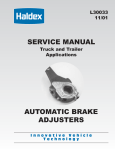

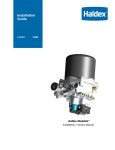
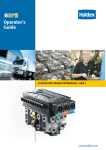
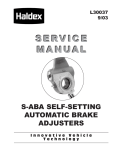
![Trailer Roll Stability (TRS) Installation Manual [L30040]](http://vs1.manualzilla.com/store/data/006020641_1-040a22153212ab13bbec744ca183c148-150x150.png)
